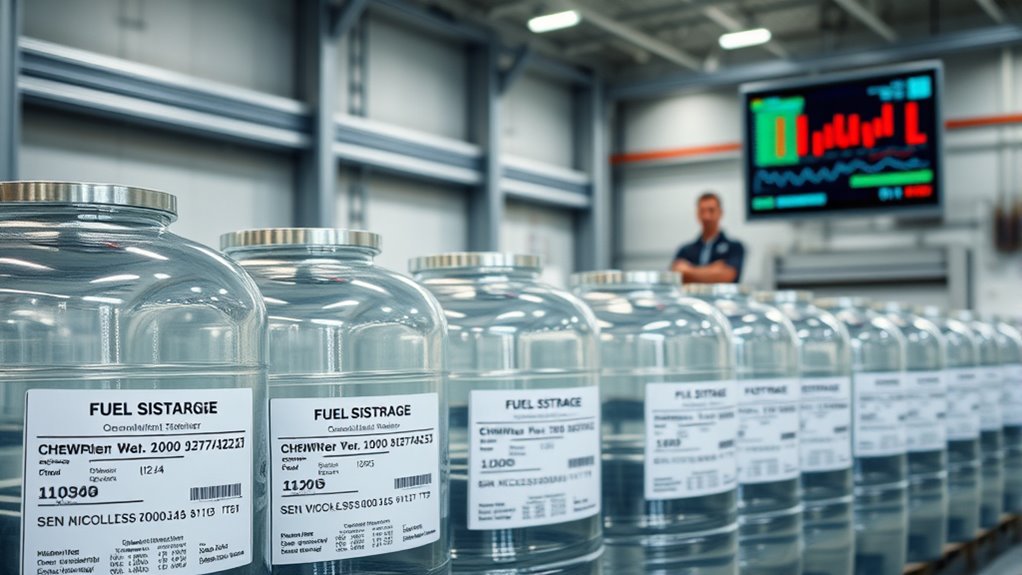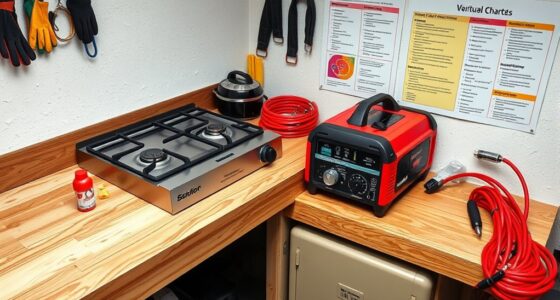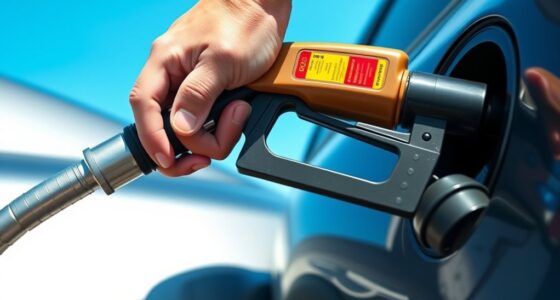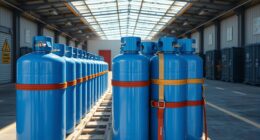For long-term fuel storage, using stabilizers is essential to keep fuel fresh and prevent degradation over time. Store your fuel in corrosion-resistant, sealed containers placed in cool, dry, well-ventilated areas to avoid rust and leaks. Regularly check container integrity and add stabilizers before extended storage. Adopting these practices helps maintain fuel quality and safety, ensuring you’re prepared whenever you need it. Explore more tips to optimize your storage system and extend shelf life.
Key Takeaways
- Stabilizers extend fuel shelf life by preventing chemical degradation and maintaining fuel quality over time.
- Using corrosion-resistant containers minimizes rust, leaks, and container deterioration during long-term storage.
- Proper storage environments—cool, dry, well-ventilated—reduce moisture buildup and slow fuel spoilage.
- Regular inspections for rust, leaks, and fuel condition are essential for ensuring storage safety and fuel viability.
- Combining stabilizers with good container choices and storage practices optimizes long-term fuel stability and shelf life.

However, even with stabilizers, you must pay attention to container corrosion. Metal containers, especially those made of steel or other reactive materials, can develop rust when exposed to fuel and moisture over time. Rust not only contaminates the fuel but can also weaken the container structure, leading to leaks and safety hazards. To prevent this, always store fuel in high-quality, sealed containers specifically designed for fuel storage. These containers often have corrosion-resistant linings or coatings that help protect against moisture and chemical reactions. Additionally, storing containers in a cool, dry, and well-ventilated area reduces the risk of condensation forming inside, which can accelerate corrosion. Regularly inspecting your storage containers for signs of rust or leaks allows you to address issues early before they compromise your fuel supply or safety. Proper storage practices also include understanding fuel compatibility, ensuring your containers and additives work effectively together. Combining the use of stabilizers with proper container maintenance creates an effective strategy for long-term fuel storage. It’s not just about adding a stabilizer and forgetting about it; you need to monitor the condition of your fuel and storage containers periodically. Properly sealed, corrosion-resistant containers, along with stabilized fuel, keep your supply safe and ready when you need it. By paying attention to additive effectiveness and container integrity, you guarantee your stored fuel remains viable, reducing waste and protecting your investments. Long-term storage requires a proactive approach, but with the right practices, you can confidently store fuel for months or even years, knowing it will perform reliably when needed.
Frequently Asked Questions
How Do Temperature Fluctuations Affect Fuel Stability Over Time?
Temperature fluctuations can considerably impact your fuel’s stability over time. As temperatures change, thermal expansion occurs, causing the fuel to expand and contract, which can lead to leaks or container stress. Additionally, these fluctuations increase condensation risks inside storage tanks, introducing moisture that promotes fuel degradation and microbial growth. To maintain fuel quality, you should minimize temperature swings and ensure proper venting, preventing these issues from compromising your stored fuel.
Are There Specific Fuel Types Better Suited for Long-Term Storage?
You should consider alternative fuel options like ethanol-free gasoline or diesel designed for long-term storage. These fuels tend to last longer and are less prone to degradation. Use storage container materials such as high-density polyethylene or metal tanks that resist chemical reactions and temperature changes. Properly sealed containers and added stabilizers can extend shelf life, making your fuel more reliable for future use.
What Are the Signs of Fuel Degradation During Storage?
You’ll notice fuel degradation through signs like a foul odor, cloudiness, or sediment buildup. Chemical changes cause the fuel to become darker and less volatile, while microbial contamination can produce slime or algae, especially in stored fuel with water. If you see these signs, it’s a clear indicator that the fuel has deteriorated and may no longer be suitable for use. Regular checks help prevent engine issues.
How Often Should Stored Fuel Be Rotated or Replaced?
Coincidentally, you should rotate or replace stored fuel every 6 to 12 months to guarantee freshness. Regularly check your storage container maintenance, especially for cracks or leaks, and monitor fuel levels to prevent moisture buildup. By staying attentive to these factors, you keep your fuel in ideal condition, reducing the risk of degradation and ensuring reliable performance when you need it most.
Can Fuel Stabilizers Be Used With All Engine Types?
Fuel stabilizers are generally compatible with most engine types, but you should check the manufacturer’s guidelines to guarantee engine compatibility. Stabilizer effectiveness varies depending on the fuel and engine, so using the right stabilizer for your specific engine helps prevent fuel degradation. Always follow dosing instructions carefully, and note that some engines, like ethanol-blended fuel systems, may require specialized stabilizers for peak performance and longevity.
Conclusion
As you imagine your stored fuel sitting quietly in its container, remember that with proper stabilizers and careful shelf life management, it stays fresh like a well-preserved treasure. When you open that container months later, it’s like unearthing a reliable friend ready to ignite your engine’s spark. Keep an eye on those stabilizers, and your fuel will remain a steadfast companion, ready to power your adventures whenever you need it most.









